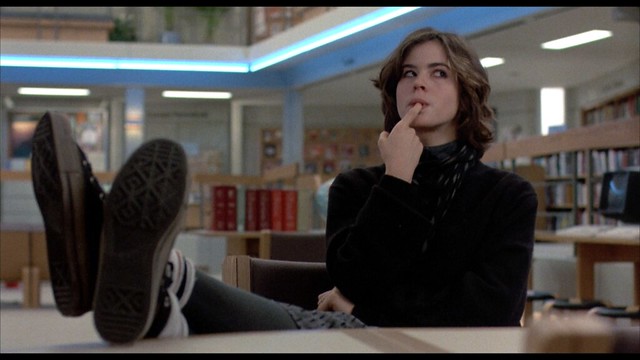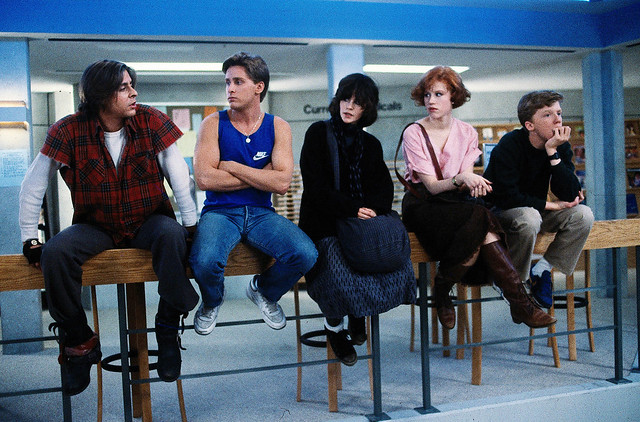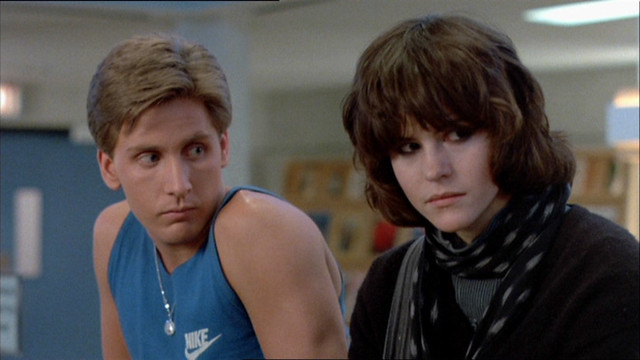Allison Reynolds, portrayed by Ally Sheedy, in The Breakfast Club
Editor’s Note: The Breakfast Club is playing in some DC movie theaters tomorrow in a restored print for its 30th anniversary. Neal Keller, DJ at the long-running 80s Dance Party, recently caught the screening, and he was compelled to share some thoughts on it, inspired by a documentary featurette that runs before the film. Keep up with Neal and the 80s Dance Party on Facebook. And stay tuned for the next 80s Dance Party, monthly at Tropicalia (2001 14th St. NW, DC).
Did Allison Sell Out?
Allison is one of the essential cinematic Goth Chicks of the 1980s. If you don’t know her, it might be because she likes it that way. She is one of five high school kids “forced to sacrifice her Saturday to detention” in the John Hughes movie “The Breakfast Club.” Draped in black clothing, beneath thick dark bangs and blackened eyes, she is determined to be ignored. And for the first part of the film, she more or less succeeds.
Unfortunately, her best efforts at going unnoticed are undermined by her subconscious longing to be noticed. The film originally came out in 1985, and in the many times I’ve seen it since, I never noticed her very much — at least not before my latest screening of it. At a recent theatrical reissue held to mark the 30th anniversary of the movie’s release, I found myself spending much more time focused on her character. This was prompted in no small part by a featurette that preceded the screening, in which the cast and guests offered their perspectives about the work 30 years later.
Filmmaker Diablo Cody (best known as the writer of “Juno”) accused Allison (played by Ally Sheedy) of “selling out” by the end of the film when she transforms from gloomy caterpillar to radiant butterfly at the film’s climax. I mean, no self-respecting Goth Chick would give up her black eyeliner, ESPECIALLY in order to *gasp* catch the eye of the star athlete, would she?! Did Allison allow Claire (played by Molly Ringwald) to recreate her image just to get his attention?
My 20-year-old self would say — did say: “SELL OUT!” But my 50-year-old self started to see it differently as I watched the film again, and pondered the question anew. I was surrounded by my current peer group at this anniversary screening, most of whom are about the same age. I suspect I wasn’t the only one wondering if I too had sold out, which proves that the film is still striking a nerve deep within us after three decades.
Of all of the films John Hughes created, this is the necessary one.
So did Allison sell out? More than a few questions are raised by the film, each of which elicits a very personal response from each viewer. The genius of the film is that Hughes included within the cast a character that each of us could relate to, but also a contrasting character that each of us were likely to resent or dismiss. Hence, the conflicts explored in the story are ones that draw the audience in — especially if you’ve ever been young. On first viewing, I had no trouble relating to Brian (the “brain,” played by Anthony Michael Hall) based on my own high school experience (although, to be fair, my grades were pretty average.) And my resentment focused most immediately on Andrew (the “athlete,” played by Emilio Estevez), based on similar experiences (surprised?). To a lesser extent, I was dismissive of Claire (the “princess”) and Bender (the “criminal,” played by Judd Nelson.)
But I missed almost entirely the importance of Allison (the “basket case”) until this recent revisit. I can relate to her much more at this point. I can also relate to the sense of betrayal that any outcast would feel by Allison’s seeming capitulation to normality. And for the sake of the JOCK, no less! I was aware of this injustice when I first saw the film, but never dwelled on it too much. I think it was much more on the minds of the girls who saw the film, as evidenced by the declaration issued by Ms. Cody when interviewed in the documentary: “Sell-out!”
Some of the other interviewees come to Allison’s defense in the documentary, including actress Ally Sheedy. She raises a good point about how true individuality should allow one to be open to all possible options, including going from Goth Chick to Debutante. (Okay, as long as the reverse is valid as well, especially if you’re like me, and you’re eternally captivated by what results.) Nevertheless, I’d like to speak up in Allison’s defense as well, and also offer a defense for the film’s director, John Hughes. Or perhaps just an informed guess on why he did what he did.
The first thing that comes to mind in defending the director’s decisions concerning Allison’s transformation is that he has to make Andrew’s attraction to her believable. If the plot sees the characters coupling up at the end (in a way that excludes the nerd, of course), it’s a longshot that the jock is going to suddenly warm up to trenchcoat girl. This explains Andrew’s motivation, but to explain Allison’s motivation requires going a bit further — more on that in a sec. In the meantime, I cannot rest on explaining away the director’s choice based on a simple plot device, because I think there’s more going on there.
Film is a medium which, most of the time, is content to be taken as representational in a literal way. Or maybe it just settles there for the sake of the audience. Viewers all too often tend to see what’s presented onscreen as if it was a newscast, shot on location, offering an eyewitness view of the lives of the characters. Who they are is who they appear to be, what we see them do and say is what they did and said. Thus the use of archetypes, especially ones that can be represented visually, which saves time on explaining each character’s backstory.
John Bender, Andrew Clark, Allison Reynolds, Claire Standish, and Brian Johnson make for unlikely friends.
This is illustrated nicely in “The Breakfast Club” by the shot of each character’s footwear as they race down the hallways of the school. But it puts us at risk of thinking we know everything about a character based on what we see. Hughes clearly wanted us to guess at what’s going on inside the characters, or fill them in with what’s going on inside us. He knew that film techniques that allow us to peer into their unseen worlds, like voiceovers or narration, would be out of place in “The Breakfast Club.” But he knew that, ultimately, it’s a film. It is to be watched and heard, likely by a young audience, so what we get is what’s on the screen. In the film “Shadow of the Vampire,” John Malkovich’s personification of silent film director Frederich Murnau declares, “If it isn’t in frame, it DOESN’T EXIST.” He’s right, but he’s also wrong. If I start to see Allison and her actions as metaphor, I start to appreciate her more.
I am aided in this because I know a thing or two about kids like Allison, especially in the context of her era. She piles on the layers of black to hide something that she wants to reveal. But she doesn’t want to give it away, she wants you to find it. With all her defenses, she is challenging you to delve in deeper to find her beauty and vulnerability. But you’ve got to be in for the whole ride. So in the alternate version that runs in my head, she never changes her hair or her face or her clothes. What we’re seeing in frame is just a projection, maybe even aspirational, of what how she thought of herself she grew. Unnurtured by her ambivalent parents, this image of herself belongs to a younger self — and anyways nobody’s interested. So it is hidden beneath dark hair and dark eyes. In my version, she keeps her outward appearance intact, and only reveals herself to those take it upon themselves to venture further.
That counts for Andrew; it also counts for Claire. That’s what a truly dedicated Goth Chick would do. The problem is that “The Breakfast Club” goes a long way to maintain honesty about the interactions of young people, so Allison might end up disappointed. With my approach, maybe the rest of the group decides to just leave her to her pixie stick sandwiches. This could be the other reason why wise old Mr. Hughes chose to have her get a makeover, or rather why Allison went along with it.
So why is it that the athlete is one chosen to find the vulnerable person within Allison? Because it’s so much more meaningful. One might expect Brian to more readily push past Allison’s superficial outer trappings than the star of the wrestling team. But that course doesn’t involve as great a leap, not for a film that is attempting to challenge us. Transformation is so utterly important to the teenager, and it is equally important to this film.
Another John Hughes movie, “Pretty in Pink,” similarly pivots on a big transformation (and to the detriment of the nerd character once again). In “Pretty in Pink,” Molly Ringwald’s character Andie passes over thrift store Duckie for prep school Blane. That film prompted an even more intense discussion on selling out that is still raging. As a dedicated nerd, I never thought I’d find myself defending Andie, but she probably saw nothing to achieve in pairing with the adoring Duckie. Blane, on the other hand, must be willing to put so much of his button-down life aside in order to be with her. In the quest for self-affirmation, she chooses fire over coals. ‘Can’t say I’ve never done the same.
A similar case can be made for “The Breakfast Club’s” Andrew. His transformation would have to be intense. The thing is, he wants to be challenged. Perhaps more so than the other characters. After all, he’s an athlete, so his life is all about challenges. Up to this point, all of his challenges have been physical, and he’s met them all. Allison offers to him a challenge that instead goes to his mind and his heart. It is the embracing of something really risky that makes one a champion. But does he realize that the Saturday detention is just a trial match? Does he know that the championship is on Monday?
Part of the discussion that inspired this writing was the question, posed by a friend who was at the screening, of what happens on to Allison and Andrew on Monday. In the version that runs in my head, even if she HAD gone through with the makeover, the next time she sees him she’s intentionally dressed in black again. She does this in order to ask, “Do you still see me? Do you still see in me what you saw in detention on Saturday?” This scenario is just as risky for her, of course. After all, Claire’s response to Brian’s posing of the question of what happens Monday was brutally honest, but probably correct. I’m not inclined to bet on Andrew’s reaction to Allison’s challenge being the right one, but I guess I’m just as cynical as Claire. The filmmaker can deliver a happy ending to the audience largely because he gets to choose where to place the ending.
Andrew and Allison
Okay. So did Allison sell out? It took 30 years, but I’ve changed my mind on this one. She didn’t.
Someone once said to me that the one who captures our heart is the one who makes us feel beautiful. Moreover, it’s someone who sees in us in a way that we were hoping to be seen: “Please see the identity that I have been carving out; I need to know it’s there.”
Adolescence is all about forging an identity, much as we try to deny it. Allison wants to know, “If I could see myself through his eyes, what would I look like?” She wants to know because she’s pretty sure she likes the person she sees reflected in the gaze of the other. One of the unanswered questions in the film is, well, just where did Allison get the white blouse that she emerges in at the end? Could it be that it was underneath those layers all along? I say it was. Even if it was just a metaphor, hidden away.
That’s my answer, and I’m cool with that because I’m pretty sure she walked out of that school in the same beat-up shoes she walked in with.
The Breakfast Club
Tuesday, March 31, 2015
Ballston Commons 12
Ballston Common Mall, 671 N. Glebe Rd., Arlington, Va.
Potomac Yards Stadium 16
3575 Jefferson Davis Hwy., Alexandria, Va. 22305
Hoffman 22
2034 Eisenhower Ave., Alexandria, Va. 22314
Tyson’s Corner 16
7850e Tysons Corner Ctr., Tysons Corner Center, Mclean, Va.
Rockville Center 13
Retail Pavilion-Rockville Center, 199 E Montgomery Ave, Rockville, Md.
+ Other venues
Tuesday, March 31
Showtime @7:30pm
aprox. $12.50







